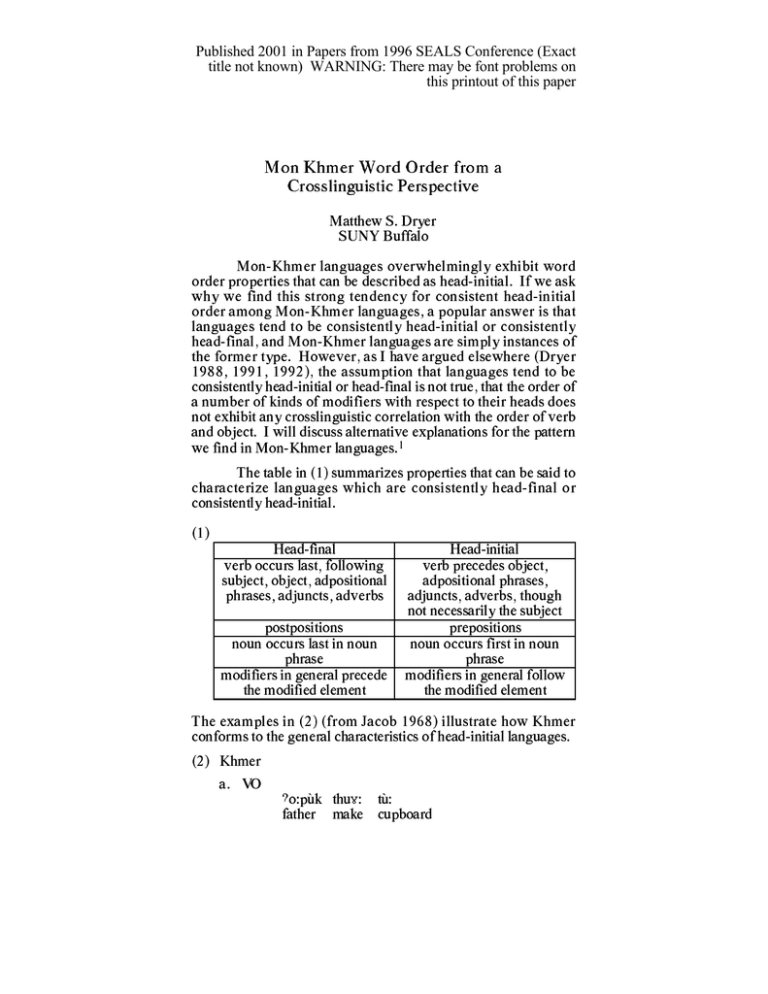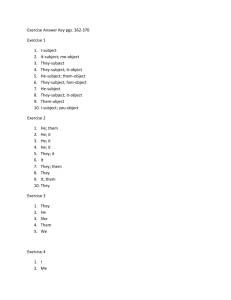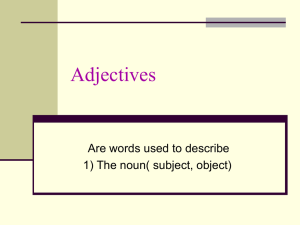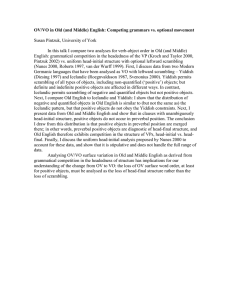Mon Khmer Word Order from a Crosslinguistic Perspective
advertisement

Published 2001 in Papers from 1996 SEALS Conference (Exact title not known) WARNING: There may be font problems on this printout of this paper Mon Khmer Word Order from a Crosslinguistic Perspective Matthew S. Dryer SUNY Buffalo Mon-Khmer languages overwhelmingly exhibit word order properties that can be described as head-initial. If we ask why we find this strong tendency for consistent head-initial order among Mon-Khmer languages, a popular answer is that languages tend to be consistently head-initial or consistently head-final, and Mon-Khmer languages are simply instances of the former type. However, as I have argued elsewhere (Dryer 1988, 1991, 1992), the assumption that languages tend to be consistently head-initial or head-final is not true, that the order of a number of kinds of modifiers with respect to their heads does not exhibit any crosslinguistic correlation with the order of verb and object. I will discuss alternative explanations for the pattern we find in Mon-Khmer languages.1 The table in (1) summarizes properties that can be said to characterize languages which are consistently head-final or consistently head-initial. (1) Head-final Head-initial verb occurs last, following verb precedes object, subject, object, adpositional adpositional phrases, phrases, adjuncts, adverbs adjuncts, adverbs, though not necessarily the subject postpositions prepositions noun occurs last in noun noun occurs first in noun phrase phrase modifiers in general precede modifiers in general follow the modified element the modified element The examples in (2) (from Jacob 1968) illustrate how Khmer conforms to the general characteristics of head-initial languages. (2) Khmer a. VO ÷o:pùk thu: tù: father make cupboard ‘Father is making a cupboard’ (p. 262) b. Verb - Nominal Adjunct p÷o:n tœu sa:la:-rì√n (p. 262) younger.sibling go school ‘(My) younger brother/sister is going to school’ c. Verb - Verbal Adjunct vì:√ tœu r√hás 3SG go quick ‘He goes quickly’ (p. 79) d. Noun-Adjective pht´œ√h to:c house small ‘a small house’ (p. 60) e. Noun-Genitive (i.e. noun possessor) pht´œ√h ta: house old.man ‘the old man’s house’ (p. 263) f. Noun-Possessor (i.e. pronoun possessor) ÷o:pùk kh˜om father 1SG ‘my father’ (p. 60) g. Noun-Numeral pht´œ√h pì:r house two ‘two houses’ (p. 62) h. Noun-Demonstrative bØntùp nìh room this ‘this room / these rooms’ (p. 64) i. Noun-Interrogative pht´œ√h na: house which ‘which house’ (p. 266) j. Adjective-Intensifier thmu nas new very ‘very new’ As shown by Dryer (1992), a number of the word order characteristics illustrated for Khmer in (2) are indeed typical of VO languages. These include the characteristics listed in (3). (3) Typical VO characteristics (Greenberg 1963, Dryer 1992) Noun-Genitive Noun-Relative Clause Prepositions Verb-PP Verb-Adverb Adjective-Marker-Standard etc. However, some of the characteristics of Khmer illustrated in (2) are not typical of VO languages, despite their involving headinitial order. These include those listed in (4). (4) Typical Mon-Khmer but NOT typical VO characteristics Noun-Adjective Noun-Demonstrative Adjective-Intensifier Below, I will illustrate each of these characteristics from other Mon-Khmer languages, and present data from a database containing data for over 750 languages showing that these are not typical VO characteristics. The examples in (5) illustrate the noun-adjective order from a number of Mon-Khmer languages. (5) a. Vietnamese nhà nho? house small ‘a small house’ (Thompson 1965: 221) b. Palaung rapya• kaªria•rª girl beautiful ‘the beautiful girl’ (Milne 1921: 38) c. Khmu÷ kòn l√œ÷œ man good ‘a good man’ (Premsrirat 1987: 30) d. Katu ao tam shirt black ‘a black shirt’ (Costello 1969: 30) e. Stiêng nhi gêq house small ‘small house’ (Miller 1976: 24) f. Chrau ie™r ma™q chicken large ‘a large chicken’ (Thomas 1971: 139) g. Sre caw-÷ùr hà˝ woman beautiful 'the beautiful woman' (Manley 1972: 156) h. Sedang m√ngê∑ 'mei person evil ‘evil person’ (Smith 1979: 77) i. Mon hØe÷ hnòk house large ‘a large house’ (Bauer 1982: 333) The data in (6) below illustrates the distribution of AN versus NA order among VO languages from my database. The data is organized in the following way (cf. Dryer 1989a, 1992). First, I have classified the languages into genetic groups, which I call genera, which are roughly comparable to the subfamilies of Indo-European, and the numbers in (6) represent the number of genera containing languages of each type. In addition, I group these genera into six large geographic areas and count the number of genera within each area.2 For example, the ‘5’ in the upper lefthand corner of (6) indicates that there are 5 genera in Africa containing languages in my database which are VO and AN, while the ‘32’ below it indicates that there are 32 genera in Africa containing languages in my database which are VO and NA. The larger figure for each area is enclosed in a box. (6) Afr Eur SEA A-NG NAm SAm Total VO&AN 5 6 4 5 17 3 40 VO&NA 32 4 12 3 7 5 63 NA order is often thought to be typical of VO languages, but the data in (6) shows that both orders are common, and that AN order is more common than NA order in 3 of the 6 areas. The order VO&NA is somewhat more common overall (by 63 genera to 40), but this difference is completely attributable to the large number of VO&NA languages in Africa: 32, or more than half of the 63 VO&NA genera, are from Africa. Outside of Africa, VO&AN is slightly more common, by 35 genera to 31. Now one might argue that NA order is still somewhat more common than AN order among VO languages and that this suggests that there is a weak correlation between VO order and NA order. However, it turns out that this weak preference for NA order is also found among OV languages, as demonstrated by the data in (7). (7) Afr Eur SEA A-NG NAm SAm Total 5 9 7 58 OV&AN 7 28 2 OV&NA 24 4 5 17 15 19 86 The data in (7) show that in 5 areas out of 6, OV&NA order is more common than OV&AN, that the latter order is more common only in Eurasia. In short, while NA order may be slightly more common among VO languages, it is also somewhat more common among OV languages. Hence, the occurrence of NA order among MonKhmer languages cannot be attributed to a general tendency for VO languages to be NA. The situation with the order of noun and demonstrative is somewhat similar. First, the examples in (8) illustrate how the normal order among Mon-Khmer languages is for the demonstrative to follow the noun. (8) Noun-Demonstrative a. Vietnamese nhà này building this ‘this building’ (Thompson 1965: 191) b. Palaung ju•arª• ina•n basket this ‘this basket’ (Milne 1921: 47) c. Khmu÷ kØ∑:n n´œ÷ kì: child little this ‘this little child’ (Premsrirat 1987: 31) d. Katu tariiq gamak achek buffalo big that ‘that big buffalo’ (Costello 1969: 34) e. Stiêng ctôc nêy place that ‘that place’ (Miller 1976: 43) f. Chrau ie™r heq chicken this ‘this chicken’ (Thomas 1971: 139) g. Sre ÷aso n´ dog that ‘that dog’ (Manley 1972: 156) h. Sedang hài tá day that ‘that day’ (Smith 1979: 78) i. Mon kwan te÷ village that ‘that village’ (Bauer 1982: 321) One Mon-Khmer language which is an exception to this pattern is Khasi, as illustrated in (9). (9) Khasi : Dem-“Article”-Noun uta u briew MASC-that MASC person ‘that man’ (Nagaraja 1985: 13) I assume that this is related to the geographical location of Khasi, in northeast India, outside the area in which NDem order is common and in an area in which most other languages are DemN. The data in (10) from my database shows that both orders of demonstrative and noun are common among VO languages. Although the overall pattern is one whereby both orders are about equally common (54 versus 56), again the large number of VO&NDem languages in Africa is distorting and DemN order is actually more common outside of Africa (by 50 genera to 22). (10) Afr Eur SEA A-NG NAm SAm Total 6 20 9 54 VO&DemN 4 8 7 VO&NDem 34 1 12 0 7 2 56 The examples in (11) illustrate how what I call intensifiers, words modifying adjectives and indicating degree, typically follow the adjective in Mon-Khmer languages. (11) Adjective-Intensifier a. Khmer thmu nas new very ‘very new’ (Jacobs 1968) b. Sre mhar na˝ fast very ‘very fast’ (Manley 1972: 219) c. Sedang lém r√lei beautiful exceptionally ‘exceptionally beautiful’ (Smith 1979: 128) d. Mon khÄh δœ˝ good quite ‘quite good’ (Bauer 1982: 387) For this pair of elements, the preference for head-initial order is less strong among Mon-Khmer languages. The examples in (22) to (26) illustrate how a number of Mon-Khmer languages exhibit some words of this sort following the adjective but others preceding. In the (a) examples, the intensifier precedes the adjective while in the (b) examples, it follows. (12) Vietnamese a. râ∑t vui very happy ‘very happy’ (Thompson 1965: 222) la™∑m b. ␣d- eªp beautiful very ‘very beautiful’ (Thompson 1965: 272) (13) Palaung a. gö•p ü•r very tired ‘very tired’ (Milne 1921: 105) b. da•ng ga™t large very ‘very large’ (Milne 1921: 104) (14) Khmu÷ a. làk p˝kà really shy ‘really shy’ (Premsrirat 1987: 42) b. kò:n l√œ÷ phó:t too.much good too.much ‘too good’ (Premsrirat 1987: 68) (15) Katu a. long gamak very big ‘very big’ (Costello 1969: 31) b. gamak pablong big very ‘very big’ (Costello 1969: 31) (16) Chrau a. mo’ya™h ma™q very big ‘very big’ (Thomas 1971: 110) b. ma™q trôq big extremely ‘extremely big’ (Thomas 1971: 110) Despite the number of languages in which both orders of intensifier and adjective are found, I am not aware of any MonKhmer language in which the normal order is Intens-Adj. Among languages in which one order is dominant, the order Adj-Intens appears to be the dominant one. Once again, crosslinguistic data shows that there is no crosslinguistic tendency for the intensifier to follow the adjective in VO languages. The data in (17) shows that both orders are about equally common among VO languages. (17) Afr Eur SEA A-NG NAm SAm Total 1 10 7 54 VO&IntensAdj 0 8 5 VO&AdjIntens 12 0 10 1 3 3 56 We can summarize what has been demonstrated to this point as follows. Mon-Khmer languages tend to be consistently head-initial, as reflected by the common orders NA, NDem, and AdjIntens. A common assumption is that these characteristics are simply typical of VO languages, as reflections of head-initial order. I have shown, however, that these characteristics are by no means typical of VO languages, so that their occurrence in Mon-Khmer languages cannot simply be explained in terms of a supposed tendency for VO languages to be head-initial. In the remainder of this paper, I will examine some alternative hypotheses for why Mon-Khmer languages might exhibit consistent head-initial order. Even though I have demonstrated that VO languages do not exhibit a general tendency to be head-initial, one might suggest that the VO languages which are not consistently headinitial are languages which were once OV and have retained certain head-final characteristics. Such an explanation is plausible for languages like Finnish, for example, which have demonstrably changed their order from OV to VO while still retaining a number of characteristics from the time when the language was OV. One might argue that the VO order in MonKhmer is very old and that Mon-Khmer languages are in some sense “purer” VO languages, without OV ancestry. The problem with this explanation is that there are a number of families or areas in which adjectives or demonstratives commonly precede the noun or intensifiers precede the adjective and in which an explanation in terms of OV ancestry seems unlikely. This includes the Austronesian family, where there is no evidence of OV ancestry and where there is considerable variation in the order of adjective and noun, sufficient variation that the prenominal position of the adjective in many languages must be relatively recent. In addition, there are two areas in the New World in which AN order and DemN order are quite common in which VO is the normal order as part of an areal phenomenon, namely Meso-America and the Pacific Northwest. The common AN order in these areas does not seem attributable to any OV ancestry. A further hypothesis would be that there is a subtype of OV languages which are consistently head-final and a subtype of VO languages which are consistently head-initial, that both subtypes belong to a general type that involves crosscategorial consistency in head position in contrast to languages that do not. But while there may indeed be such a subtype for OV languages, illustrated by Japanese, closer examination of Mon-Khmer languages shows that they are often not entirely head-initial, that many of them exhibit sporadic exceptions to the trend towards head-initial order, so that in fact we cannot say that Mon-Khmer languages are consistently head-initial without exception. Consider, for example, the order of numeral and noun. While some Mon-Khmer languages are NNum, as in (18), others place the numeral before the noun, as in (19). (18) Noun-Numeral a. Khmu÷ kØœ:œ n pà:r kòn child two CLSFR ‘two children’ (Premsrirat 1987: 34) b. Khmer pht£√œ h pì:r house two ‘two houses’ (Jacob 1968: 62) c. Mon nØm chu÷ pØn nØm CLSFR tree four CLSFR ‘four trees’ (Bauer 1982: 359) (19) Numeral-Noun a. Vietnamese ba cái nhà three CLSFR house ‘three houses’ (Thompson 1965: 198) b. Katu pe (panong) anuq three (CLSFR) dog ‘three dogs’ (Costello 1969: 26) c. Chrau du vanông gapu one CLSFR buffalo ‘one buffalo’ (Thomas 1971: 133) d. Sre bàr n√m ÷asØ n£ two CLSFR dog that ‘those two dogs’ (Manley 1972: 156) e. Sedang môi to ket one CLSFR frog ‘one frog’ (Smith 1979: 86) Other languages, such as Palaung and Stiêng, illustrated in (20) and (21), employ two patterns with numerals, one without a classifier, in which the numeral precedes the noun, and a second with a classifier in which the numeral plus classifier follows the noun. (20) Palaung: Num+Noun or Noun+Num+Clsfr a. a•r ru• b. bra•nª g u• to• two village horse one CLSFR ‘two villages’ ‘one horse’ (Milne 1921: 57) (21) Stiêng: Num+Noun or Noun+Num+Clsfr a. pêy snam b. nhi baar ◊c three year house two CLSFR ‘three years’ ‘two houses’ (Miller 1976: 31, 32) Now one might argue that in constructions with a classifier, the classifier is really the head and the noun is itself a modifier, unlike the analysis commonly assumed for European languages. However, it seems unlikely that in some MonKhmer languages the classifier is head while in others the noun is head. If we claim that the classifier is consistently the head, then the languages in (18), in which the numeral plus classifier follows the noun would not be exhibiting a head-initial construction. Furthermore, if we restrict attention to the order of numeral and classifier, which is apparently always Num + Classifier in Mon-Khmer languages, we have a further problem, because the numeral is most plausibly analysed as a modifier of the classifier, in which case we have a further example of an order which is not head-initial. A further example of a type of modifier that commonly precedes the noun is plural words (cf. Dryer 1989b), separate words indicating the plurality of the noun phrase, as in (22). (22) a. Vietnamese nhuµng chó PLURAL dog ‘dogs’ (Thompson 1965: 179) b. Stiêng bol ôi au PLUR morning here ‘these mornings’ (Miller 1976: 34) c. Sedang vai drôh PLUR girl ‘the girls’ (Smith 1979: 92) Such plural words typically precede the noun in Mon-Khmer languages, again contrary to the general trend towards consistent head-initial order. And in various Mon-Khmer languages there are further sporadic instances of other sorts of prenominal modifiers. For example, in Mon, the quantifier meaning ‘every’ precedes the noun (in contrast to numerals which follow the noun), as in (23). (23) Mon: NNum but QuantN ˝oa r3hœ every day ‘every day’ (Bauer 1982: 343) In (24) is a summary chart of the Mon-Khmer languages in my database. In most of these langauges, we find at least one instance in which a modifier precedes the word it modifies, thus showing that completely consistent head-initial order is apparently the exception. (24) Summary chart 3 Khasi Palaung Khmu÷ Vietnamese Katu Stiêng Chrau Sre Brao Sedang Khmer Mon Gen Adj Dem Num Art Plur Intens other NG NA DemN NumN ArtN PlN AdjInt/ NOrd intadj QuantN IntN NG NA NDem NumN/ IntAdj/ NNum AdjInt NG NA NDem NNum IntAdj/ AdjInt NG NA NDem NumN DefN PlN IntAdj/ AdjInt NG/ NA NDem NumN/ IntAdj/ ClsfrN gn /an nnum AdjInt NG NA NDem NumN/ PlN NNum NG NA NDem NumN IntAdj/ NOrd AdjInt NG NA NDem NumN AdjInt NG NA NDem NNum NG NA NDem NumN PlN AdjInt NOrd QuantN NG NA NDem NNum NArt AdjInt NInt NG NA NDem NNum NDef NPl AdjInt QuantN This suggests that while there may be a general trend towards head-initial order in Mon-Khmer, we cannot say that they are consistently head-initial, thus casting doubt on the idea that the instances in which they are head-initial can be explained in terms of some general rule of head-initial order. So why do the Mon-Khmer languages exhibit a stronger tendency towards head-initial languages than VO languages elsewhere in the world? The simplest explanation would be that these orders in MK languages are simply accidental, that their occurrence does not reflect a greater pattern, any more than a random win on a slot machine. While much effort in modern linguistics is to find appealing explanations for specific phenomena in different languages, the possibility that many phenomena have no real explanation should not be overlooked. According to this view, the fact that the adjective and the demonstrative generally follow the noun in Mon-Khmer languages, and that intensifiers so often follow the adjective are simply among the many arbitrary properties found in any language, and any attempt to reduce them to some more abstract principle may simply be misguided. Notes 1 It should be noted that the pattern exhibited by Mon-Khmer languages is part of an overall pattern within Asia, in which Mon-Khmer languages exhibit head-initial characteristics, shared with Daic languages, and contrasting sharply with languages to the north and west, which exhibit head-final characteristics (e.g. Japanese, Korean, Mongolian, Turkic, Uralic, Indo-Iranian, Dravidian), with a belt of languages in between exhibiting mixed characteristics (Chinese, Tibeto-Burman, Miao-Yao). The properties of Mon-Khmer languages discussed here are thus part of a larger areal pattern that includes Daic languages, and one Mon-Khmer language, Khasi, spoken in northeast India, does not exhibit as clear a head-initial pattern. For this reason, the phenomenon being discussed is really an areal phenomenon rather than something specific to Mon-Khmer, though I will restrict attention here to Mon-Khmer. 2 The abbreviations for the six areas are: Afr = Africa, Eur = Eurasia, SEA = Southeast Asia and Oceania, A-NG = AustraliaNew Guinea, NAm = North America, and SAm = South America. SEAsia & Oceania includes the languages of Southeast Asia, Sino-Tibetan, and Austronesian languages. Eurasia contains the remaining languages of Europe and Asia. 3 Key to summary chart in (24): Gen Genitive Pl Plural Word Adj Adjective Intens Intensifier Dem Demonstrative Quant Quantifier Num Numeral Ord Ordinal Numeral Art Article Int Interrogative Modifier Def Definite marker Clsfr Classifier References Bauer, Christian Hartmut Richard. 1982. Morphology and Syntax of Spoken Mon. University of London Ph.D. dissertation. Costello, Nancy A. 1969. The Katu noun phrase. In MonKhmer Studies III, Publication No. 4 of the Linguistics Circle of Saigon, pp. 21-35. Summer Institute of Linguistics. Dryer, Matthew S. 1988. Object-verb order and adjective-noun order: dispelling a myth. Lingua 74: 77-109. Dryer, Matthew S. 1989a. Large linguistic areas and language sampling. Studies in Language 13: 257-292. Dryer, Matthew S. 1989b. Plural words. Linguistics 27: 865895. Dryer, Matthew S. 1991. SVO languages and the OV:VO typology. Journal of Linguistics 27: 443-482. Dryer, Matthew S. 1992. The Greenbergian word order correlations. Language 68: 81-138. Greenberg, Joseph H. 1963. Some universals of grammar with particular reference to the order of meaningful elements. In Joseph Greenberg, ed., Universals of Language, pp. 73113. Cambridge, Mass: MIT Press. Jacob, Judith M. 1968. Introduction to Cambodian. London: Oxford University Press. Keller, Charles E. 1976. A Grammatical Sketch of Brao, A Mon-Khmer Language. Work Papers 20, Supplement 1. Summer Institute of Linguistics, North Dakota: University of North Dakota. Manley, Timothy M. 1972. Outline of the Sre Structure. Honolulu: University of Hawaii Press. Miller, Vera Grace. 1976. An Overview of Stieng Grammar. Work Papers, Vol. 20, Supplement 3. University of North Dakota: Summer Institute of Linguistics. Milne, Mary Lewis. 1921. An Elementary Palaung Grammar. London: Oxford University Press. Nagaraja, K. S. 1985. Khasi: A Descriptive Analysis. Pune: Deccan College Post-Graduate & Research Institute. Premsrirat, Suwilai. 1987. A Khmu Grammar. In Papers in South-East Asian Lingusitics No. 10, Pacific Linguistics, Series A, No. 75. Canberra: Australian National University. Rabel, Lili. 1961. Khasi, a Language of Assam. Baton Rouge: Louisiana State University Press. Smalley, William A. 1961. Outline of Khmu÷ Structure. New Haven, Conn.: American Oriental Society. Smith, Kenneth. 1979. Sedang Grammar: Phonological and Syntactic Structure. Pacific Linguistics, Series C, No. 50. Australian National University. Thomas, David D. 1971. Chrau Grammar. Honolulu: University of Hawaii Press. Thompson, Laurence. 1965. A Vietnamese Grammar. Seattle: University of Washington Press. It should be noted that the pattern exhibited by Mon-Khmer languages is part of an overall pattern within Asia, in which Mon-Khmer languages exhibit head-initial characteristics, shared with Daic languages, and contrasting sharply with languages to the north and west, which exhibit head-final characteristics (e.g. Japanese, Korean, Mongolian, Turkic, Uralic, Indo-Iranian, Dravidian), with a belt of languages in between exhibiting mixed characteristics (Chinese, Tibeto-Burman, Miao-Yao). The properties of Mon-Khmer languages discussed here are thus part of a larger areal pattern that includes Daic languages, and one Mon-Khmer language, Khasi, spoken in northeast India, does not exhibit as clear a head-initial pattern. For this reason, the phenomenon being discussed is really an areal phenomenon rather than something specific to Mon-Khmer, though I will restrict attention here to Mon-Khmer. 1 2 The abbreviations for the six areas are: Afr = Africa, Eur = Eurasia, SEA = Southeast Asia and Oceania, A-NG = AustraliaNew Guinea, NAm = North America, and SAm = South America. SEAsia & Oceania includes the languages of Southeast Asia, Sino-Tibetan, and Austronesian languages. Eurasia contains the remaining languages of Europe and Asia. 3 Key to summary chart: Gen Adj Dem Num Art Def Genitive Adjective Demonstrative Numeral Article Definite marker Pl Intens Quant Ord Int Clsfr Plural Word Intensifier Quantifier Ordinal Numeral Interrogative Modifier Classifier







